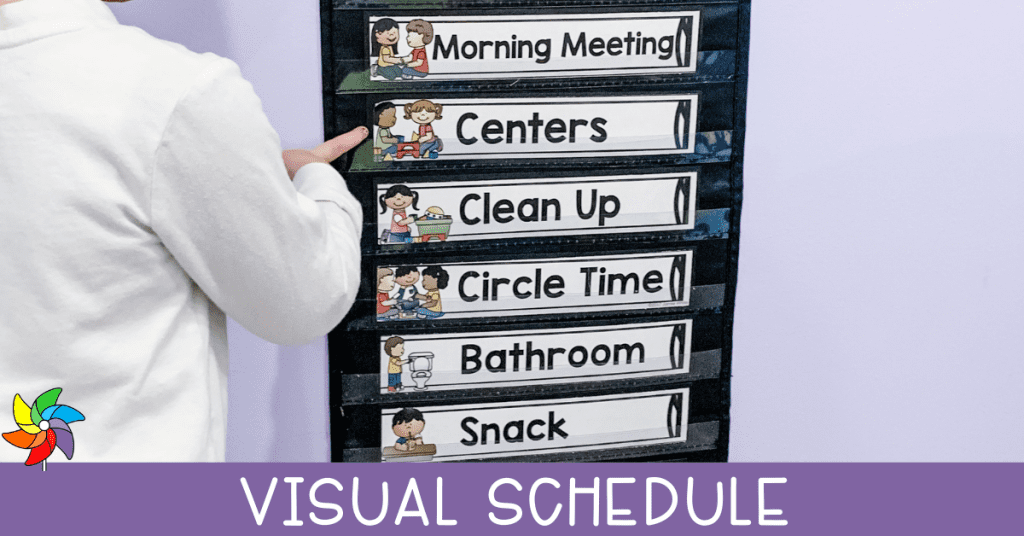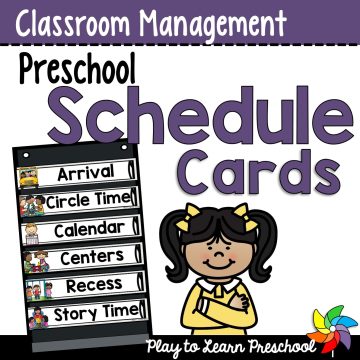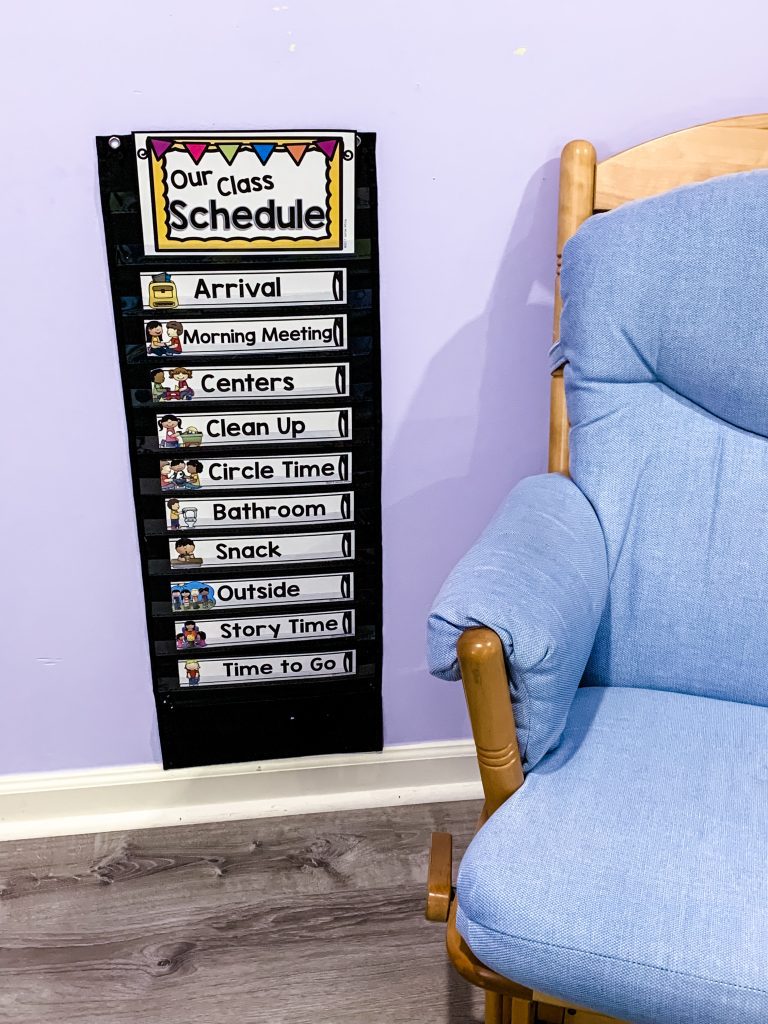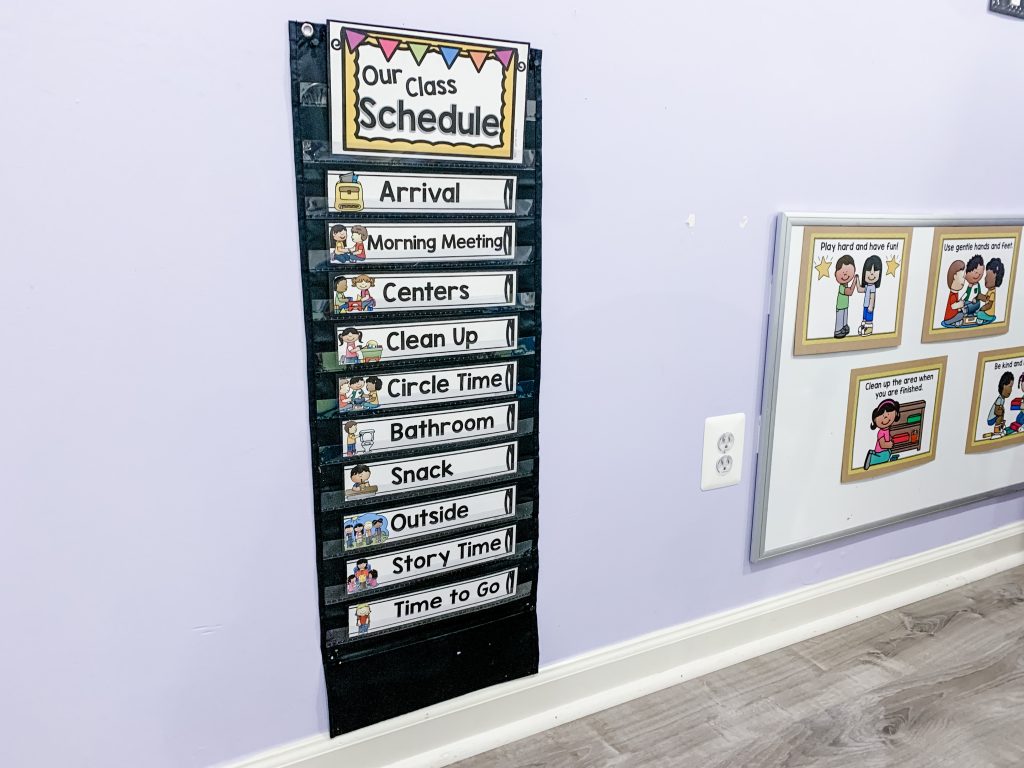what to hang up in a preschool classroom
At that place are many benefits to using a visual schedule in the classroom. They can be a multi-tool for keeping students organized, encouraging independence, reducing meltdowns, and more than.

Visual Schedule every bit Calendar Time
Agenda time doesn't have to focus on a monthly calendar. That large time catamenia can be difficult for young students to grasp. Begin small, with a daily schedule, and so students can see the progress of time and put meaning to words such every bit "before" and "after." As students get older, a weekly calendar is a stride upward. There, students tin can add words such equally "today," "tomorrow," and "yesterday." This makes the concept of a calendar much more attainable for small children to comprehend.
A Patience Booster
Preschoolers are, overall, not the best at waiting. Having a visual schedule can help reduce the number of times a child asks, "Is it time to do centers nonetheless?" Young learners can reference the schedule and come across that they have to do circumvolve time and music first. It also makes it easier to get through non-preferred tasks if a student knows that a favorite activity follows shut backside.
Visual Schedules as a Literacy Lift
It is important to provide pictures and words with visual schedules. Used every bit another literacy learning tool, the visual schedule becomes a great source of environmental text. Students recognize the unlike words such as "Circle Time" and "Snack," even when the pictures are covered.
Check out this Resources from my Store!

Preschool Schedule Cards
$iii.00
Young children function best in the classroom when they know exactly what to expect! Use these PRESCHOOL SCHEDULE CARDS to create a visual schedule to hang in your classroom. The cards fit perfectly into a pocket chart! This set includes 64 cards.
Sequencing with a Visual Schedule
Time is a difficult concept for immature learners. Sometimes, visual schedules accept clocks or times listed side by side to the pictures and words. This tin can be overwhelming for most preschoolers. Instead, focusing on sequencing words such every bit "start," "next," and "concluding" can be easier to empathise. Words that express temporal relations, such as "before" and "after," are likewise easy to practice with a visual schedule.

Primary Managing Transitions
Sometimes, preschool students can be stubborn. It's a natural part of development, but it also isn't very helpful in the classroom environment! Having a visual schedule to reference eliminates arguments about if snack time will happen earlier or after exterior time. Information technology also assists in giving students accelerate notice when information technology's time to move to a new action. Phrases such as "When the timer goes off, what is next on the schedule?" Students have a clear reminder of what happens next. The teacher tin even comprehend or flip schedule cards as each part of the day is complete. A pupil who is anxious most their parent returning can meet the time ticking down without even reading a clock!
Visual schedules make it easy to alert students to a schedule alter. During morning meeting or circle time, the teacher merely has to point out that improver or alter. This accommodates students that need a little more than time to adapt to changes.
Reinforce and Supplement Verbal Instructions with a Visual Schedule
"In one ear and out the other!" Often, preschoolers are distracted by all of the things around them. Verbal instructions might not be high on their listing when they're thinking well-nigh their friends, the toys they want to play with, and getting outside to that playground. Even for focused students, a visual schedule reinforces and supplements what the teacher has said, and children can refer to information technology over the class of the solar day. This is also excellent for many neurodivergent learners, who may have difficulty processing verbal instructions, but can interpret a visual cue with relative ease. For some students, a small copy of the schedule they can carry, or even a checklist on a clipboard, helps build independence alongside alternative communication.

Visual Schedules Make Children Feel Safety
Providing students with a visual schedule to check throughout the solar day helps reassure them because they know what is happening next. Schedules are a great way to develop autonomy and set students up for a successful school experience.
Preschoolers can exist broken-hearted when going to school for the first fourth dimension. It is a daunting experience not to know what to expect. Having a visual schedule in the preschool classroom can help to reduce that "not-knowing-what's-next" anxiety. Having that schedule follow a set up routine adds predictability and stability. This predictability besides helps reduce the number of problematic behaviors that stem from anxiety.
Having a visual reminder that the children tin reference gives them some control over whatsoever lingering anxiety about what might happen in the mean solar day. Information technology's similar to a kid scared of the dark using a flashlight or nightlight.
Schedules and routines are essential for immature learners – and honestly, adults too! Routines provide a feeling of safety. Knowing what volition happen next makes the unknown known. And children that are feeling safe are children that are gear up to learn.
Boosted Resource
Routines and Transitions – some of the most critical parts of the mean solar day. A great commodity past NAEYC.
This article goes in-depth on the science behind using a visual schedule with preschool-aged children.
mitchellwhady1951.blogspot.com
Source: https://playtolearnpreschool.us/visual-schedule/
0 Response to "what to hang up in a preschool classroom"
Postar um comentário